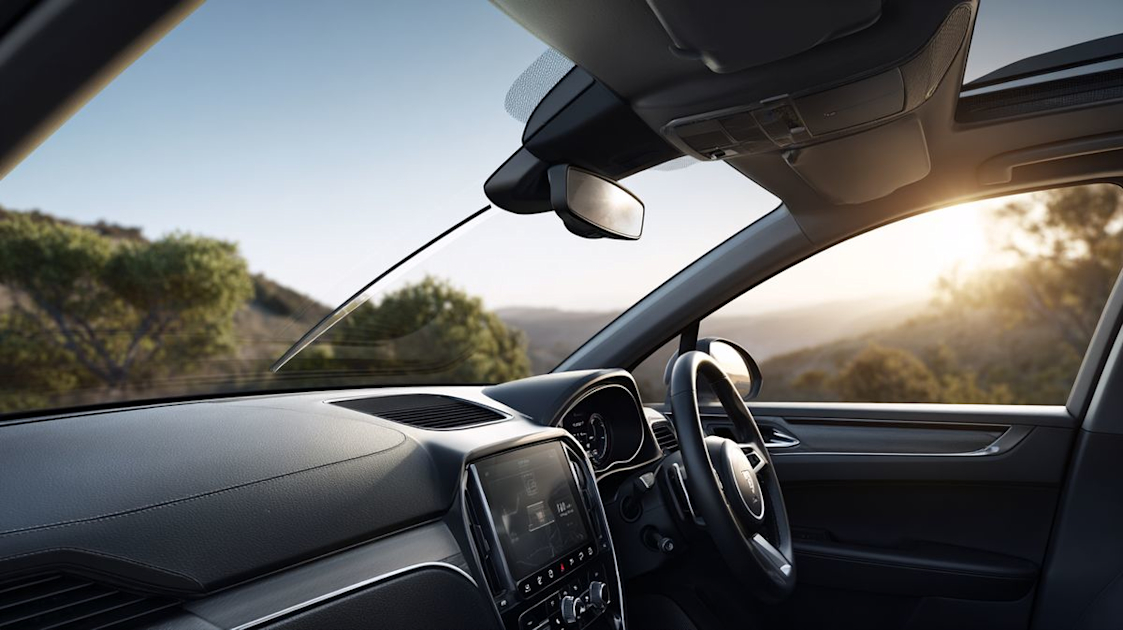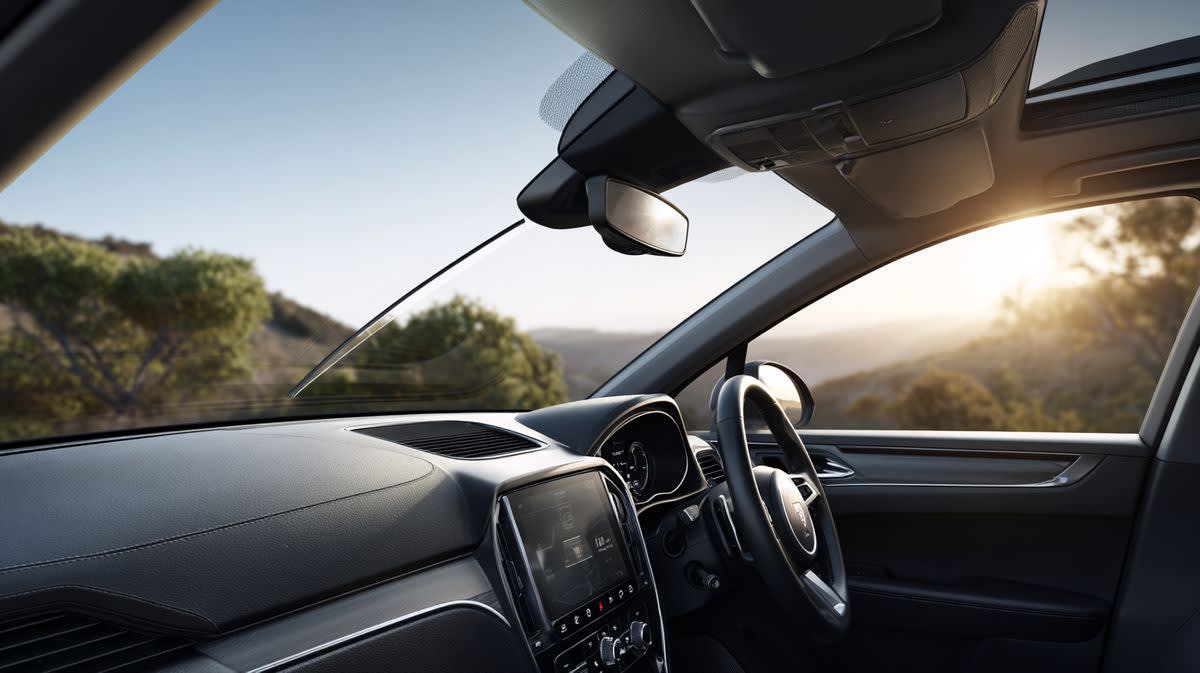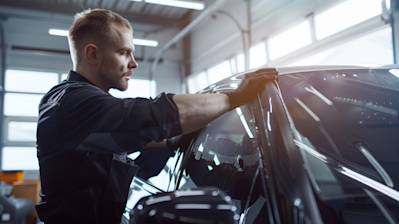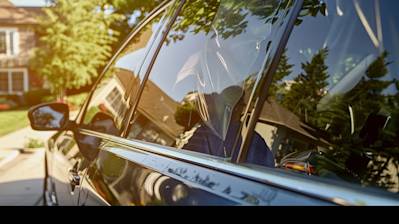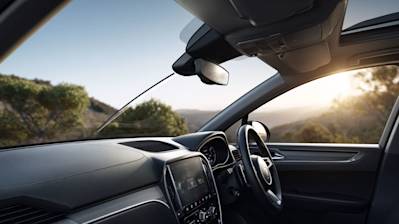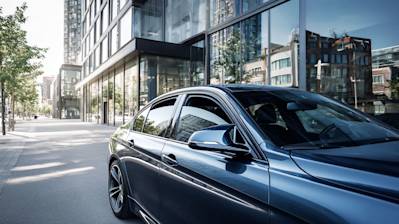A windshield tint strip, often referred to as a sun strip or sun visor strip, is a narrow band of tint applied to the top portion of a vehicle's windshield. This practical addition is not just a decorative accessory for your car. Instead, it offers several functional benefits that can enhance driving comfort and safety, especially during daytime driving.
The Purpose Behind Tint Strips
Primarily, the windshield sun strip is designed to reduce glare from the sun. When driving, particularly during sunrise or sunset, the sun's rays can create a blinding glare that compromises visibility. This strip acts as a barrier to these intense rays, allowing drivers to maintain a clear view of the road without squinting or straining their eyes.
Beyond tackling the bright sun, a windshield tint strip also serves as a shield against headlight glare at night. Though less pronounced, it minimizes the dazzling effect when oncoming traffic has excessively bright headlights.
Key Benefits of Applying a Sun Visor Strip
Enhanced Visibility and Safety
By cutting down on glare, a tint strip for your windshield significantly enhances visibility. This reduction in glare allows drivers to focus better on the road ahead, decreasing the chances of distractions or potential accidents.
Heat Reduction
A tinted windshield strip can also help in reducing the amount of heat entering through the windshield. While it isn't the primary role of the strip, every little bit helps when it comes to keeping your car cooler in the blazing heat of summer.
UV Protection
High-quality tint films can also offer protection against harmful UV rays. Much like sunglasses for your car, they reduce exposure to ultraviolet rays, helping to protect both the interior of your car from fading and passengers from sunburn.
Aesthetic Appeal
Let's not forget the aesthetic allure. A windshield tint strip adds a sleek, finished look to the vehicle, like a perfectly chosen pair of sunglasses. For many car enthusiasts, it gives a more polished and cohesive design to their beloved vehicle.
Legal Considerations
One of the critical aspects to consider when opting for a windshield tint strip is legality. Tint laws vary from state to state, and it's essential to be mindful of these before applying any kind of window tint.
Understanding Tint Laws
Most states have specific regulations regarding the placement and darkness of window tints on vehicles. While all states allow some form of tint strip on the front windshield, they often regulate the strip's size and the level of darkness. Typically, the law mandates that the sun strip should not extend more than a few inches from the top of the windshield.
For instance, some states have a limitation of around four to six inches, whereas some might allow tint up to the "AS1" line, which is a marker that denotes the maximum permissible line for a tint strip on a windshield. It's crucial to consult your local laws or a professional installer to ensure compliance.
Consequences of Violating Tint Laws
Using a tint strip that exceeds legal limits may result in fines, required removal, or issues during vehicle inspections. Understanding these rules helps avoid any legal troubles and ensures a smooth driving experience.
Choosing the Right Windshield Tint Strip
When it comes to adding a visor strip to a windshield, not all tints are created equal. Several factors influence the choice, from material quality to color options.
Material Choices
-
Dyed Film: This is the most economical option. It effectively reduces glare and heat but doesn’t block as much UV light as other types.
-
Metalized Film: This offers better UV protection and heat reduction but may interfere with electronic signals and devices.
-
Carbon Film: Combining aesthetics with functionality, carbon films do not fade over time and offer substantial UV protection without signal interference.
-
Ceramic Film: Though the most expensive, ceramic films provide excellent UV and heat rejection without affecting electronic devices and signaling.
Color Options
While black and charcoal are the most common choices for a windshield tint strip, other colors are available for those looking to add a personalized touch. Blue, green, and bronze are among the more popular options, though availability may vary by location and provider.
Quality and Durability
Investing in a high-quality sun strip for the front windshield will offer better longevity, maintaining both its functionality and appearance over several years. Cheaper films might peel, bubble, or fade quickly, leading to increased replacement costs.
Installation Process
For those inclined to add a front windshield tint strip themselves, a detailed understanding of the installation process is crucial. However, professional installation is often recommended for the best results.
DIY Installation
If you're considering a DIY approach, here’s a simplified guide:
-
Preparation: Clean the area thoroughly to ensure no dirt or dust is trapped under the film. A good cleaning solution is crucial for a smooth installation.
-
Measurement and Cutting: Measure the desired width of your tint strip, ensuring compliance with local laws. Carefully cut the film to size, allowing some extra film as a margin of error.
-
Application: Peel the backing of the film and apply it onto a wet windshield, starting from the middle and working your way outwards to push out air bubbles.
-
Final Touches: Trim excess film and use a squeegee to secure the tint strip firmly, ensuring there are no bubbles or creases.
Professional Installation
For those less comfortable with a DIY process, professional installers can guarantee a flawless application, often with a warranty. They have the correct tools, space, and experience to ensure the sun visor strip for your windshield is compliant and perfect.
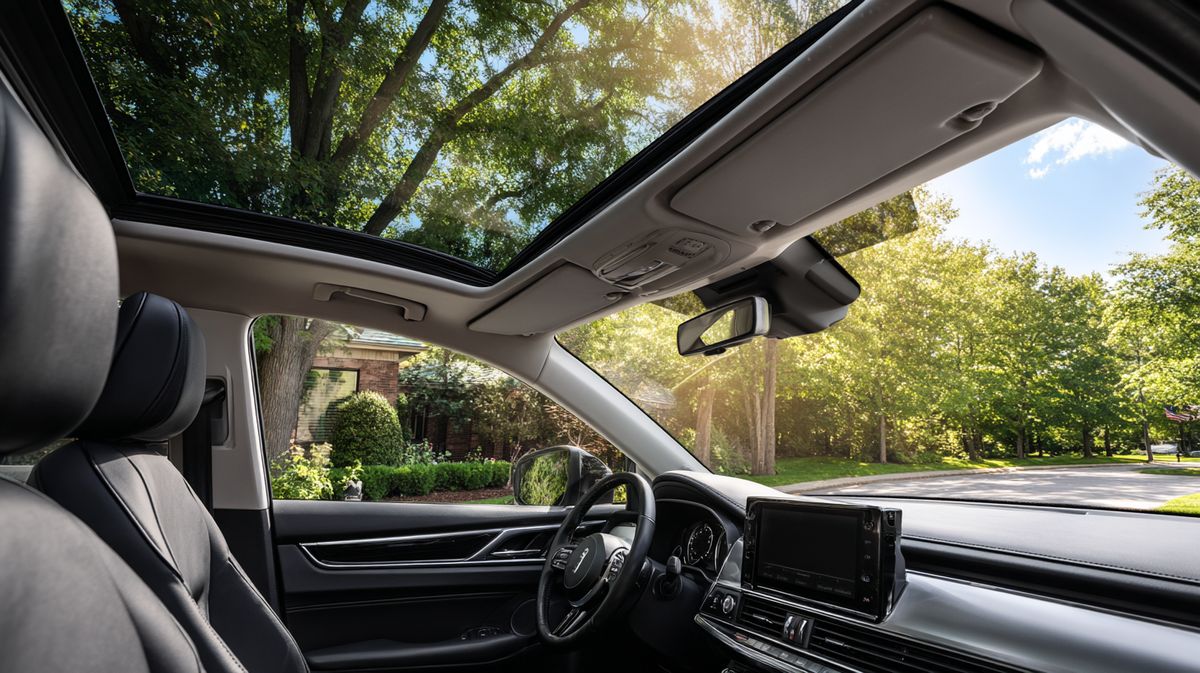
Frequently Asked Questions about Windshield Tint Strip
Will a tinted strip on my windshield block too much light?
Not at all! A windshield tint band is designed to provide that perfect balance where it blocks excessive light without making anything too dark. It's just enough to keep those glaring sun rays at bay while ensuring your vision of the road remains crystal clear.
Is a windshield sunstrip legal in my area?
Laws regarding windshield tinting can vary significantly by state and even by country. Many regions have specific regulations about how much of the windshield can be covered or the darkness of the tint that can be applied. It's crucial to check local vehicle codes before getting a windshield band installed. Keep in mind that reputable tint installers are usually familiar with these regulations, so they can be a great resource for information.
How do I choose the right shade for my windshield tint band?
Selecting the right shade for your windshield tint strip comes down to two factors: personal preference and legal limitations. While darker shades provide better glare reduction and privacy, they might not be legal in all areas. Lighter shades can be more universally accepted and still offer a level of protection from sunlight. Think about your driving habits—if you drive a lot at dusk or sunrise, a slightly darker strip might be more beneficial.
How is a windshield tint strip installed?
Installing a windshield tint strip is typically a job best left to professionals, especially if you want the cleanest and most durable finish. The process involves cleaning the upper portion of your windshield, applying a soap solution, and then carefully adhering the tint strip to the glass. It has to be properly aligned and trimmed to fit, ensuring it doesn't impede your view or violate any regulations. Professionals have the tools and expertise to handle this precisely.
Can I install a windshield band strip myself?
Yes, if you enjoy DIY projects and have some patience, you can install a windshield tint strip yourself. You'll need a roll of tint film that's designed for automotive windows, a squeegee, a knife or blade for trimming, and soapy water to help apply it smoothly. There are plenty of online tutorials and videos that can guide you through the process. However, be aware that DIY installation can be tricky, and a less than perfect application can result in bubbles or an uneven finish.
How do I maintain and clean a windshield sunstrip?
Maintaining a windshield tint strip is pretty straightforward. Avoid using any harsh chemicals or abrasive materials on the tint film. A gentle cleanser and a soft cloth or sponge should do the trick. Regularly cleaning the area will help keep it in top condition. Also, try to avoid sticking anything to the tint strip, such as decals, which could damage the film.
Will a windshield tint band affect my vision at night?
Generally, a windshield tint strip should not negatively impact your vision at night since it's installed on the top portion of your windshield, where your view is least frequent. However, if your strip is on the darker side, it could slightly alter the perception of oncoming lights. It's all about finding a shade that you are comfortable with and complies with local regulations.
Is a windshield tint strip removable?
Yes, you can remove a windshield tint strip if you decide it’s not for you or if you need to change it for legal reasons. Removing it involves peeling off the film carefully and cleaning any adhesive residue left behind. Again, professional services can ensure there's no damage to the windshield during removal.
How long does a windshield tint strip last?
The longevity of a windshield tint strip largely depends on the quality of the material used and how well it’s maintained. High-quality tints can last anywhere from 5 to 10 years or more. Regular cleaning and avoiding abrasive materials can prolong the life of the strip, allowing you to enjoy its benefits for many years.
Can I have other tints alongside my windshield tint band?
You can definitely opt for additional tinting on your side and rear windows along with your windshield tint strip, as long as they comply with local legal requirements. Combining them can improve the overall aesthetic of your vehicle while ensuring a uniform level of privacy and protection from sunlight.
How do I know if the installer used high-quality tint film?
Reputable installers typically use high-quality film brands that come with warranties. Asking about the brand and warranty of the tint used can give you peace of mind. High-quality films usually have UV protection and do not fade, bubble, or peel easily. If possible, check reviews or references for the installer ahead of time to ensure you’re getting a reliable service.

Pros
Reduced Glare
One of the biggest advantages of having a windshield tint strip is the significant reduction in glare from the sun. That extra bit of shading at the top of the windshield can cut down on the sunlight that comes directly into your eyes, particularly when the sun is low on the horizon during sunrise or sunset. Less glare means a clearer view of the road and a reduced likelihood of eye strain, which makes for a safer and more comfortable driving experience.
Enhanced Comfort
With reduced glare comes improved comfort while driving. It can be really annoying when the sun is in your eyes, and you have to squint to see what's happening ahead. A tint strip helps in blocking that glaring sunlight, making driving more pleasurable, especially during long road trips.
UV Protection
Windshield tint strips also provide an added layer of UV protection, albeit smaller in coverage compared to full-window tints. This area of protection can reduce the exposure to harmful ultraviolet rays for anyone in the vehicle. It's particularly beneficial for the driver, who spends a lot of time exposed directly to the sunlight while driving.
Reduced Interior Fading
This extra UV protection not only helps protect occupants from harmful rays but also slows down the fading of the car's interior materials. Dashboards, upholstery, and other interior surfaces are prone to sun damage over time. By blocking some of the sunlight, a tint strip can help extend the lifespan of these materials, keeping the interior looking newer for longer.
Improved Privacy
Though not as comprehensive as a full tint, a strip can provide a small amount of additional privacy. While it won't make your entire vehicle's interior hidden, it helps obscure the view from higher angles, making it a bit more difficult for onlookers or passers-by to catch a glimpse inside the vehicle.
Aesthetic Appeal
Let's face it—a windshield tint strip can enhance the appearance of your vehicle. It adds a sleek and finished look that complements the car's style, often making it look cooler and more cohesive. This can be a big plus for car enthusiasts or anyone who takes pride in their vehicle's visual appeal.
Cons
Legal Restrictions
One of the primary drawbacks of adding a windshield tint strip is navigating the legal restrictions. Tint laws vary from state to state and even country to country, setting limits on how much tint can be applied and where. It's important to ensure the tint strip complies with local laws to avoid fines or being required to remove the tint altogether.
Risk of Non-Compliance
The risk is not minor, considering that having an illegal tint can result in being stopped by law enforcement, fines, or even having to alter the tint to meet legal requirements. It’s a hassle and can be costly if you have to make changes.
Potential for Distorted Vision
While a windshield tint strip is designed to improve your driving experience, it might have the opposite effect if not done correctly. Poor-quality tint or an improper installation could result in bubbles, waves, or peeling that obscures the driver's view, creating a safety hazard. Additionally, a tint that's too dark might also make it challenging to see clearly in low-light conditions or at night.
Reduced Visibility During Bad Weather
During heavy rain or snow, visibility is already reduced, and a windshield tint strip could make it even harder to see in these conditions. Although the strip is small, any additional obstruction could make a big difference in adverse weather.
Impact on Resale Value
For some buyers, a windshield tint strip might be seen as a plus, but for others, they may view it negatively, particularly if it's either illegal or poorly applied. This could potentially affect the resale value of the vehicle, as some buyers might prefer factory-standard features without any modifications.
Installation Costs
While not excessively expensive, installing a windshield tint strip does involve a cost, both for the tint itself and the labor to install it properly. Though some might attempt a DIY approach, professional installation is recommended to avoid the risks of bubbles and peeling, adding to the overall cost.
Potential for Heat Buildup
While large-scale window tinting can help reduce heat buildup inside a car, a small windshield tint strip might inadvertently cause uneven heating on the glass, particularly if the rest of the windshield isn't tinted. This isn't a huge issue but could lead to minor discomfort if there's a noticeable temperature difference between shaded and unshaded areas.

Myths / Misconceptions about Windshield Tint Strips
Windshield Tint Strips are Illegal Everywhere
One of the most pervasive myths about windshield tint strips is that they are universally illegal. The truth is that legality varies greatly from one location to another. While certain states or countries may have stringent regulations about tinting windshields, others allow it within specific limits.
Variation in State Laws
In the United States, for example, each state has distinct laws regarding the allowable darkness and reflectiveness of tint strips. Some states allow a tint strip only at the top of the windshield within a certain range of inches, while others may permit more flexibility. Therefore, before assuming it's completely banned, it’s crucial for drivers to check the local laws where their vehicle is registered.
Windshield Tint Strips Cause Impaired Vision
Another common misconception is that windshield tint strips severely impair the driver's vision. While it's true that an excessively dark tint can reduce visibility, most legal tint strips are designed to enhance, rather than hinder, visibility, especially in bright sunlight.
Adaptable to Varying Light Conditions
Modern window tints are made of high-quality materials that allow them to effectively reduce glare from the sun and the oncoming headlights of cars at night without severely darkening the view. These tint strips are crafted to be optically clear and many drivers find them beneficial in improving comfort and visibility by minimizing eye strain.
Tint Strips Make the Interior Noticeably Cooler
Some people believe that a windshield tint strip alone can drastically reduce the temperature inside the vehicle. While tint strips contribute to lowering the amount of heat entering through the windshield, the difference isn't usually as dramatic as some may expect.
Contribution to Overall Cooling
Windshield tint strips do play a role in rejecting solar heat, but for significant cooling effects, it’s typically necessary to have comprehensive window tinting on all glass surfaces of the car. Thus, while a tint strip certainly contributes to making the interior feel cooler, it should not be seen as a standalone solution.
All Windshield Tint Strips Are the Same
It’s a common misconception that all windshield tint strips offer the same level of protection and aesthetic appeal. In reality, there is a myriad of options available in terms of materials, shades, and quality.
Variety in Materials and Shades
Tint strips can be made from various materials such as dyed film, metalized, carbon, or ceramic, each offering different performance characteristics. For example, ceramic tints are often highly recommended for their superior heat rejection and minimal signal interference. Similarly, the available spectrum of shades allows car owners to customize their vehicles' appearance while still complying with legal standards.
Installation is Simple and DIY-Friendly
Many believe that installing a windshield tint strip is a straightforward, do-it-yourself project. While it’s certainly possible for handy individuals to install these strips themselves, achieving professional results can be challenging.
Importance of Professional Installation
Achieving a smooth, bubble-free finish requires skill and precision. Professionals use specialized tools and techniques to ensure that the tint is applied seamlessly and lasts for a long time. Moreover, a professional installation often includes a warranty or guarantee for the materials and the installation itself, providing peace of mind against peeling or bubbling.
Tinted Windshield Strips Decrease Vehicle Resale Value
A tint strip on the windshield is often thought to decrease a vehicle's resale value. However, the impact on resale depends on a variety of factors, such as the quality of the material used, the condition of the tint, and the preferences of potential buyers.
Enhancements to Aesthetic and Comfort
For many buyers, a well-applied windshield tint strip that adheres to legal standards can actually enhance the desirability of a vehicle. It can improve the car’s appearance, offer comfort features, and signal to buyers that the vehicle was cared for, potentially making it more attractive on the resale market.
Tint Strips Interfere with Electronic Devices
Some people assume that all tint strips interfere with electronic devices due to the materials used. While certain types of tint, like metalized films, may affect signal reception, many modern tint materials are specifically designed to avoid this problem.
Significance of Material Choice
Ceramic and carbon tints are particularly favored for vehicles nowadays because they typically do not interfere with radio, GPS, or mobile device signals. The technology in modern tints ensures that drivers can enjoy the benefits of reduced glare and heat without compromising their connectivity.
Any Level of Darkness is Acceptable for Tint Strips
Another common misunderstanding is that any level of darkness is acceptable for the tint strip, as long as it's not on the lower part of the windshield. In practice, there are often specific guidelines governing the allowable darkness even for tint strips.
Legal Limitations and Safety Considerations
Regulatory bodies usually specify not just the placement but also the visible light transmission (VLT) percentage for tint strips. These restrictions are put in place to balance the benefits of tinting, such as UV protection and reduced glare, with the necessity of maintaining clear visibility for safe driving. Therefore, it’s always wise to double-check the legal requirements to ensure compliance.
Summary
So, if you’re considering adding a little extra flair to your car, a windshield tint strip might just be what you need. Not only does it help reduce glare and protect your eyes from the sun, but it adds a cool, sleek look to your vehicle. It's an affordable touch-up that could make those sunny days on the road much more enjoyable. Just remember to check your local regulations to make sure you're within the legal limits.
All in all, a windshield tint strip is a nifty addition that serves dual purposes. It plays a role in comfort by keeping the sun out of your eyes while driving, which can enhance safety and reduce strain. Plus, it contributes to the overall aesthetic appeal of your car. With a variety of shades and types to choose from, you can customize your ride to suit your personal style, no need for a big investment or dramatic changes.
Wrapping it up, throwing in a windshield tint strip could be a smart move for anyone looking to spruce up their car without doing anything too drastic. It's practical, provides a bit more privacy, and can even help in maintaining cooler temperatures inside the car. Whether you're commuting or hitting the open road, it’s a small upgrade that makes driving a little more enjoyable, without breaking the bank.
About A+ Window Tinting
Welcome to A+ Window Tinting, the leading window tinting service in Roseville, CA! With a passion for enhancing both the aesthetic and functional aspects of your vehicle or home, our skilled professionals are dedicated to delivering top-notch results. As a locally-owned business, we pride ourselves on our exceptional customer service and commitment to quality. Whether you're looking to reduce glare, increase privacy, or protect your interiors from harmful UV rays, we’ve got the perfect solution tailored to your needs. Feel the difference with our premium materials and expert installation, and discover why so many Roseville residents trust A+ Window Tinting for all their tinting needs. Come visit us today and see the A+ difference for yourself!

